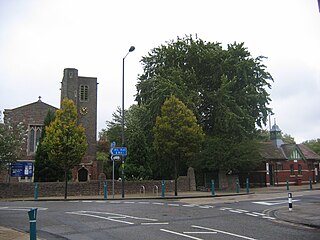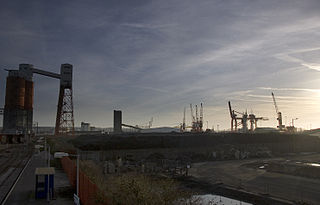Related Research Articles

Mustard gas or sulfur mustard is any of several chemical compounds that contain the chemical structure S(CH2CH2Cl)2. In the wider sense, compounds with the substituent S(CH2CH2X)2 and N(CH2CH2X)3 are known as sulfur mustards and nitrogen mustards, respectively, where X = Cl or Br. Such compounds are potent alkylating agents, which can interfere with several biological processes. Also known as mustard agents, this family of compounds are infamous cytotoxins and blister agents with a long history of use as chemical weapons. The name mustard gas is technically incorrect: the substances, when dispersed, are often not gases but a fine mist of liquid droplets. Sulfur mustards are viscous liquids at room temperature and have an odor resembling mustard plants, garlic, or horseradish, hence the name. When pure, they are colorless, but when used in impure forms, such as in warfare, they are usually yellow-brown. Mustard gases form blisters on exposed skin and in the lungs, often resulting in prolonged illness ending in death. The typical mustard gas is the organosulfur compound bis(2-chloroethyl) sulfide.
Rio Tinto Alcan is a Canada-based mining company. Headquartered in Montreal, Quebec, it is a subsidiary of global mining conglomerate Rio Tinto. It was created on 15 November 2007 as the result of the merger between Rio Tinto's Canadian subsidiary and Canadian company Alcan.

Avonmouth is a port and outer suburb of Bristol, England, facing two rivers: the reinforced north bank of the final stage of the Avon which rises at sources in Wiltshire, Gloucestershire and Somerset; and the eastern shore of the Severn Estuary. Strategically the area has been and remains an important part of the region's maritime economy particularly for larger vessels for the unloading and exporting of heavier goods as well as in industry including warehousing, light industry, electrical power and sanitation. The area contains a junction of and is connected to the south by the M5 motorway and other roads, railway tracks and paths to the north, south-east and east.

Rio Tinto Group is a British-Australian multinational company that is the world's second largest metals and mining corporation. It was founded in 1873 when a group of investors purchased a mine complex on the Rio Tinto, in Huelva, Spain, from the Spanish government. It has grown through a long series of mergers and acquisitions. Although primarily focused on extraction of minerals, it also has significant operations in refining, particularly the refining of bauxite and iron ore. It has joint head offices in London, England and Melbourne, Australia.

Industrial wastewater treatment describes the processes used for treating wastewater that is produced by industries as an undesirable by-product. After treatment, the treated industrial wastewater may be reused or released to a sanitary sewer or to a surface water in the environment. Some industrial facilities generate wastewater that can be treated in sewage treatment plants. Most industrial processes, such as petroleum refineries, chemical and petrochemical plants have their own specialized facilities to treat their wastewaters so that the pollutant concentrations in the treated wastewater comply with the regulations regarding disposal of wastewaters into sewers or into rivers, lakes or oceans. This applies to industries that generate wastewater with high concentrations of organic matter, toxic pollutants or nutrients such as ammonia. Some industries install a pre-treatment system to remove some pollutants, and then discharge the partially treated wastewater to the municipal sewer system.

Kennecott Utah Copper LLC (KUC), a division of Rio Tinto Group, is a mining, smelting, and refining company. Its corporate headquarters are located in South Jordan, Utah. Kennecott operates the Bingham Canyon Mine, one of the largest open-pit copper mines in the world in Bingham Canyon, Salt Lake County, Utah. The company was first formed in 1898 as the Boston Consolidated Mining Company. The current corporation was formed in 1989. The mine and associated smelter produce 1% of the world's copper.
Boliden AB is a Swedish multinational metals, mining, and smelting company headquartered in Stockholm. The company produces zinc, copper, lead, nickel, silver, and gold, with operations in Sweden, Finland, Norway, and Ireland.

The Avonmouth Docks are part of the Port of Bristol, in England. They are situated on the northern side of the mouth of the River Avon, opposite the Royal Portbury Dock on the southern side, where the river joins the Severn estuary, within Avonmouth.
Gossage is a family name of soapmakers and alkali manufacturers. Their company eventually became part of the Unilever group. During World War II, all soap brands were abolished by British government decree in 1942, in favour of a generic soap. When conditions returned to normal post war, the Gossage brand was not revived by Unilever though the company name is still registered for legal purposes. The online 'Times Index' shows meetings of the Gossage company board until the early 1960s.

The Tiwai Point Aluminium Smelter is an aluminium smelter owned by Rio Tinto Group (79.36%) and the Sumitomo Group (20.64%), via a joint venture called New Zealand Aluminium Smelters (NZAS) Limited.
Zinc smelting is the process of converting zinc concentrates into pure zinc. Zinc smelting has historically been more difficult than the smelting of other metals, e.g. iron, because in contrast, zinc has a low boiling point. At temperatures typically used for smelting metals, zinc is a gas that will escape from a furnace with the flue gas and be lost, unless specific measures are taken to prevent it.
Consolidated Zinc was an Australian mining company from 1905 to 1962.
Kanahooka is a southern suburb in Wollongong City Council. It has a few shops and a playground. Situated on Lake Illawarra is a Park with a playground. It has a public school and a high school.

Chittening is an industrial estate in Avonmouth, Bristol, England, bypassed by the A403 road, near the River Severn. It lies within the city boundary of Bristol, in Avonmouth ward, but used to be beyond it, in historic Gloucestershire, on former marshland at the southern end of the Vale of Berkeley.
Capper Pass and Son Ltd. was a British smelting and refining company specialising in non-ferrous metal refining, particularly tin. Originally established in Bristol in the early 1800s, the company relocated to a site on the banks of the Humber Estuary at Melton, East Riding of Yorkshire, in the 1930s, with the Bristol factories closing in the 1960s. Rio Tinto Zinc acquired the firm in the 1960s.
Chemical weapons were widely used by the United Kingdom in World War I. The use of poison gas was suggested by Winston Churchill and others in Mesopotamia during the interwar period, and also considered in World War II, although it appears that they were not actually used in these conflicts. While the UK was a signatory of the Hague Conventions of 1899 and 1907 which outlawed the use of poison gas shells, the conventions omitted mention of deployment from cylinders.
National Filling Factory, Banbury, officially called National Filling Factory No. 9. was a British Ministry of Munitions filling factory, constructed during World War I and located in Banbury, Oxfordshire. The production of filled shells began in April 1916 and ended when the factory closed in 1924
The chemical industry in the United Kingdom is one of the UK's main manufacturing industries. At one time, the UK's chemical industry was a world leader. The industry has also been environmentally damaging, and includes radioactive nuclear industries.

The Mattheissen and Hegeler (M&H) Zinc Company was a zinc manufacturing company headquartered in LaSalle, Illinois. At one time, the family-owned company was the largest zinc manufacturing plant in the United States. The company brought zinc ore from Wisconsin and Missouri to the coal fields of Northern Illinois. The company and its founders had a large influence in the development of LaSalle & Peru, Illinois.

Risdon Zinc Works is a major zinc refinery located in Lutana, a suburb of Hobart, Tasmania, Australia. The smelter is one of the world's largest in terms of production volume, producing over 280,000 tonnes annually of high-grade zinc, primarily as die-cast alloys and continuous galvanising-grade alloys. These products are exported for global markets and utilised in a wide range of industries and products, from building and infrastructure to transportation, business equipment, communications, electronics, and consumer goods. The facility produces zinc using the Roast, Leach, Electrowinning (RLE) method, creating leach byproducts, including cadmium, gypsum, copper sulphate, lead sulphate, sulphuric acid, paragoethite and leach concentrate. The refinery has been owned and operated by the global multi-metals business Nyrstar since 2007. Nyrstar Hobart works closely with the Nyrstar Port Pirie multi-metals smelter in South Australia. The facility is Tasmania's largest exporter, contributing 25% of the state's overall export value in 2013.
References
- 1 2 3 "Downstream innovation – chemical and zinc production at Avonmouth". University of the West of England . Retrieved 12 May 2014.
- ↑ Telford Taylor (1 November 1993). The Anatomy of the Nuremberg Trials: A Personal Memoir. Little, Brown & Company. ISBN 978-0-3168-3400-1 . Retrieved 20 June 2013.
- ↑ Thomas Graham, Damien J. Lavera (May 2003). Cornerstones of Security: Arms Control Treaties in the Nuclear Era. University of Washington Press. pp. 7–9. ISBN 978-0-2959-8296-0 . Retrieved 5 July 2013.
- 1 2 Haber L.F. (1986). "10". The Poisonous Cloud. Oxford University Press. ISBN 9780198581420.
- 1 2 David Large. The Port of Bristol, 1848–1884. Bristol Record Society.
- 1 2 3 "Photographic Archive of Avonmouth Bristol BS11". BristolPast.co.uk. Retrieved 12 May 2014.
- ↑ Ian F.W. Beckett (31 December 2013). The Home Front 1914–1918: How Britain Survived the Great War. ISBN 9781472908896 . Retrieved 13 May 2014.
- ↑ John Green (11 March 2009). "Bristol and the Zinc Industry". Retired Professional Engineers' Club, Bristol. Retrieved 15 April 2009.
- ↑ "Cobar's Mining History" (PDF). Primefacts. Department of Primary Industries (New South Wales). February 2007. Retrieved 15 April 2009.
- ↑ "RTC-CRA: United for Growth" (PDF). Rio Tinto Review. Rio Tinto. September 2006. Archived from the original (PDF) on 27 March 2009. Retrieved 13 April 2009.
- ↑ "Bomb squad at old mustard gas factory". Bristol Post. 1 August 2012. Retrieved 12 May 2014.
- ↑ "Work suspended after mustard gas scare on Avonmouth site". Bristol Post. 16 May 2012. Retrieved 4 December 2015.
- ↑ "New Asda distribution centre on former mustard gas site". Consumer Health Resource Centre. Archived from the original on 8 December 2015. Retrieved 4 December 2015.